Content for TS 23.303 Word version: 17.1.0
5.3.4 Discovery reporting
5.3.4.1 Match report (non-roaming) - open discovery
5.3.4.1A Match Report (non-roaming) - restricted discovery
5.3.4.2 Match report (roaming/inter-PLMN transmission) - open discovery
5.3.4.2A Match Report (roaming/inter-PLMN transmission) - restricted discovery
5.3.4A Discovery reporting - Model B procedures
5.3.4A.1 Match report (non-roaming) - restricted discovery
5.3.4A.2 Match report (roaming/inter PLMN discovery transmission) - restricted discovery
...
...
5.3.4 Discovery reporting p. 81
5.3.4.1 Match report (non-roaming) - open discovery p. 81
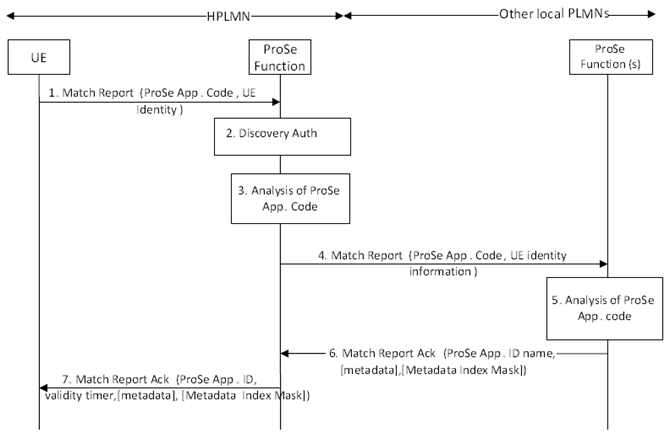
Step 1.
If the PLMN that assigned the given ProSe Application Code is another Local PLMN then steps 4-7 are executed, otherwise (i.e. the ProSe Application Code was assigned by HPLMN) only step 7 is executed:
If the UE finds ProSe Application Code(s) that matches the Discovery Filters and does not have ProSe Application ID(s) already locally stored that correspond to this ProSe Application Code(s), or these ProSe Application Code(s) excluding the Metadata Index are stored locally with the corresponding ProSe Application ID(s) but the Metadata Index(s) of the received and stored codes are different, the UE it shall (re)establish a secure connection with the ProSe Function in HPLMN to which it shall then send a Match Report (ProSe Application Code(s), UE Identity, Monitored PLMN ID) message to the ProSe Function in HPLMN. The ProSe Application Code is the code that the corresponding Discovery Filter of the UE matched. This request is always sent to the ProSe Function in HPLMN. The UE Identity is set to e.g. IMSI. The Monitored PLMN ID is the PLMN in which the UE has monitored the ProSe Application Code.
If application-controlled extension is used, the UE may initiate a Match Report procedure if there is match on the ProSe Application Code Prefix, and there is a match on the ProSe Application Code Suffix, but the ProSe Protocol layer in the UE doesn't have the ProSe Application ID corresponding to the ProSe Application Code Prefix stored locally.
Step 2.
The ProSe Function shall check the context for this UE that contains its subscription parameters. The authorisation information also contains the PLMN that this UE is allowed to perform discovery. The HSS provides the MSISDN of the UE.
Step 3.
The ProSe Function analyses the ProSe Application Code(s) received from the UE.
If the dynamic metadata is used and the PLMN that assigned the given ProSe Application Code(s) is the HPLMN, the ProSe Function in the HPLMN locates the latest metadata(s) associated with the ProSe Application Code(s).
Step 4.
The ProSe Function in HPLMN sends a Match Report (ProSe Application Code(s), UE identity, Monitored PLMN ID) to the ProSe Function of the PLMN that assigned the ProSe Application Code. The UE identity information e.g. IMSI or MSISDN can be used by the ProSe Function in Local PLMN to perform charging.
Step 5.
The ProSe Function ensures that the received ProSe Application Code is authorized to be transmitted on the monitored PLMN, i.e. the pair of ProSe Application Code and the monitored PLMN is stored in the UE context. The ProSe Function analyses the ProSe Application Code(s) received from the UE. As the "announcing" UE is not roaming, the ProSe function only needs to check whether the received ProSe Application Code(s) is still valid.
If the dynamic metadata is used, the ProSe Function(s) in the other PLMN(s) locates the latest metadata(s) associated with the ProSe Application Code(s).
Step 6.
If the ProSe Application Code is confirmed then the ProSe Function in Local PLMN shall send Match Report Acknowledgement (ProSe Application ID Name(s), validity timer(s)). This message may also contain certain metadata corresponding to the ProSe Application ID Name e.g. postal address, phone number, URL etc.
If the dynamic metadata is used, the metadata(s) and the Metadata Index Mask(s) corresponding to the ProSe Application Code(s) are sent along with the Match Report Acknowledgement message(s).
Step 7.
The ProSe Function in HPLMN shall respond to the UE with Match Report Acknowledgment (ProSe Application ID(s), validity timer(s), [metadata(s)], [Metadata Index Mask(s)]). This message may also contain certain metadata corresponding to the ProSe Application ID Name e.g. postal address, phone number, URL etc. The validity timer(s) indicate for how long the mapping of ProSe Application Code(s) and ProSe Application ID(s) provided are going to be valid. The UE stores the mapping of ProSe Application Code(s) and corresponding ProSe Application ID(s) for the duration of their validity timer.
If the dynamic metadata is used, the Metadata Index Mask(s) for the corresponding metadata(s) are also sent to the UE in the Match Report Acknowledgment message. The UE stores the Metadata Index Mask with the corresponding ProSe Application Code(s) and ProSe Application ID(s).
5.3.4.1A Match Report (non-roaming) - restricted discovery |R13| p. 83
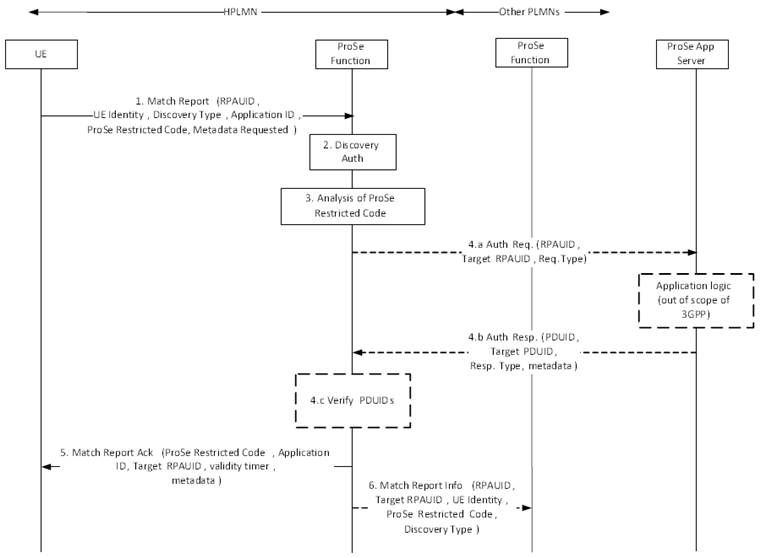
Figure 5.3.4.1A-1: Match Report procedure for restricted discovery (non-roaming)
(⇒ copy of original 3GPP image)
(⇒ copy of original 3GPP image)
Step 1.
When the monitoring UE has received a ProSe Restricted Code over the air that matches the Discovery Filter it obtained from monitoring Request procedure, and if the UE does not have a corresponding RPAUID associated with it with a valid TTL, the UE sends a Match Report (RPAUID, UE Identity, Discovery Type, Application ID, ProSe Restricted Code, Metadata Requested) message to the ProSe Function in the HPLMN to get the Target RPAUID. The RPAUID is the identifier the monitoring UE used to obtain the Discovery Filter from the Monitoring Request. The UE Identity is set to e.g. IMSI. The Application ID represents a unique identifier of the application that triggered the monitoring Request. Discovery Type is set to "restricted discovery". The ProSe Restricted Code is the code received over the air.
If restricted Direct Discovery with application-controlled extension is used, the UE may initiate a Match Report procedure if there is match on the ProSe Restricted Code Prefix, and there is a match on the ProSe Restricted Code Suffix, but the ProSe Protocol layer in the UE doesn't have the ProSe Restricted App User ID corresponding to the ProSe Restricted Code Prefix stored locally. Once the ProSe Protocol layer in the UE has got the ProSe Restricted App User ID corresponding to the ProSe Restricted Code Prefix stored locally, the ProSe Restricted Code Suffix is passed to the application in the UE.
If the monitoring UE decides that it needs to obtain the latest metadata, e.g. when the Metadata Indicator allows metadata update, and the UE has noticed a change of the metadata (e.g. from the suffix or via other means), it includes Metadata Requested in the Match Report message.
Step 2.
The HPLMN ProSe Function checks the authorization for the monitoring UE to perform restricted discovery.
Step 3.
The HPLMN ProSe Function analyses the ProSe Restricted Code and identifies in the UE context of the monitoring UE the corresponding Target RPAUID.
Step 4.a.
Optionally, the ProSe Function sends a Auth Request (RPAUID, Target RPAUID, Request Type) to the ProSe Application Server. The ProSe Function locates the ProSe Application Server based on the Application ID. The Request Type is set to "restricted discovery/match". If the Metadata Requested is included in the Match Report in step 1, the ProSe Function shall send the Auth Request message.
Step 4.b.
If, based on the permission setting, the RPAUID is allowed to discover the Target RPAUID, the ProSe Application Server returns a Auth Response (PDUID, Target PDUID, Response Type, metadata) message. The PDUID corresponds to RPAUID, the Target PDUID corresponds to the Target RPAUID stored in the ProSe Application Server. The Response Type is set to "restricted discovery/match ack". This message may also contain certain metadata corresponding to the Target PDUID, e.g. welcome message, etc.
Step 4.c.
The ProSe Function verifies that the returned PDUID belongs to the requesting UE, and the Target PDUID is the same as the stored Target PDUID.
Step 5.
The ProSe Function in HPLMN returns a Match Report Ack (Application ID, Target RPAUID, validity timer, metadata) to the UE. The UE stores the mapping between the RPAUID, the ProSe Restricted Code and the Application ID for the duration of the validity timer.
Step 6.
The ProSe Function in HPLMN may optionally send a Match Report Info (RPAUID, Target RPAUID, UE Identity, ProSe Restricted Code, Discovery Type) to the ProSe Function of the announcing UE. Discovery Type is set to "restricted discovery".
5.3.4.2 Match report (roaming/inter-PLMN transmission) - open discovery p. 84
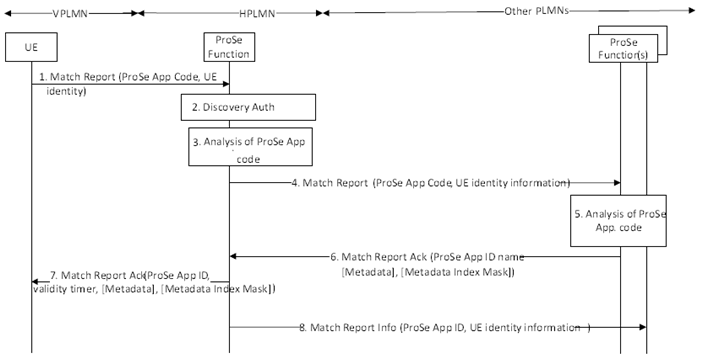
Step 1.
If the PLMN that assigned the given ProSe Application Code is not the HPLMN, then steps 4-8 are executed, otherwise (i.e. the HPLMN assigned the ProSe Application Code) only steps 7-8 are executed:
If the UE finds ProSe Application Code(s) that matches the Discovery Filters and does not have ProSe Application ID(s) already locally stored that correspond to this ProSe Application Code(s) or these ProSe Application Code(s) excluding the Metadata Index are stored locally with the corresponding ProSe Application ID(s) but the Metadata Index(s) of the stored and received codes are different, the UE (re)establishes a secure connection with the ProSe Function in HPLMN and sends a Match Report (ProSe Application Code(s), UE Identity, VPLMN ID, Monitored PLMN ID) message to the ProSe Function in HPLMN. The ProSe Application Code is the code that the corresponding Discovery Filter of the UE matched. The UE Identity is set to e.g. IMSI. The Monitored PLMN ID is the PLMN in which the UE has monitored the ProSe Application Code.
If application-controlled extension is used, the UE may initiate a Match Report procedure if there is match on the ProSe Application Code Prefix, and there is a match on the ProSe Application Code Suffix, but the ProSe Protocol layer in the UE doesn't have the ProSe Application ID corresponding to the ProSe Application Code Prefix stored locally.
Step 2.
The ProSe Function shall check the context for this UE that contains its subscription parameters for this UE. The authorisation information also contains the PLMN that this UE is allowed to perform discovery. The UE context also contains the VPLMN ID where the UE is registered. The HSS provides the MSISDN of the UE.
Step 3.
The ProSe Function analyses the ProSe Application Code(s) received from the UE.
If the dynamic metadata is used and the PLMN that assigned the given ProSe Application Code(s) is the HPLMN, the ProSe Function in the HPLMN locates the latest metadata(s) associated with the ProSe Application Code(s).
Step 4.
The ProSe Function in HPLMN sends a Match Report (ProSe Application Code(s), UE identity, Monitored PLMN ID) to the ProSe Function of the PLMN that assigned the ProSe Application Code (i.e. the ProSe Function of the HPLMN of the "announcing UE"). The UE identity information e.g. IMSI or MSISDN can be used by the ProSe Function in Local/Visited PLMN to perform charging.
Step 5.
The ProSe Function ensures that the received ProSe Application Code is authorized to be transmitted on the monitored PLMN, i.e. the pair of ProSe Application Code and the monitored PLMN is stored in the UE context. The ProSe Function analyses the ProSe Application Code(s) received from the UE, and confirms the ProSe Application Code(s).
If the dynamic metadata is used, the ProSe Function(s) in the other PLMN(s) locates the latest metadata(s) associated with the ProSe Application Code(s).
Step 6.
The ProSe Function shall send Match Report Acknowledgement (ProSe Application ID Name(s), validity timer(s)). This message may also contain certain metadata corresponding to the ProSe Application ID Name e.g. postal address, phone number, URL etc.
If the dynamic metadata is used, the metadata(s) and the Metadata Index Mask(s) corresponding to the ProSe Application Code(s) are sent along with the Match Report Acknowledgement message(s).
Step 7.
The ProSe Function in HPLMN shall respond to the UE with Match Report Acknowledgment (ProSe Application ID(s), validity timer(s), [metadata(s)], [Metadata Index Mask(s)]). This message may also contain certain metadata corresponding to the ProSe Application ID Name e.g. postal address, phone number, URL etc. The validity timer(s) indicate for how long the mapping of ProSe Application Code(s) and ProSe Application ID(s) provided are going to be valid. The UE stores the mapping of ProSe Application Code(s) and corresponding ProSe Application ID(s) for the duration of their validity timer.
If the dynamic metadata is used, the Metadata Index Mask(s) for the corresponding metadata(s) are also sent to the UE in the Match Report Acknowledgment message. The UE stores the Metadata Index Mask with the corresponding ProSe Application Code(s) and ProSe Application ID(s).
Step 8.
If the the Monitored PLMN ID is different from the PLMN ID contained in the ProSe Application Code, i.e. the "announcing UE" is roaming or performs inter-PLMN discovery transmission, the ProSe Function in HPLMN may optionally send a Match Report Info (ProSe Application ID(s), UE Identity) to the ProSe Function of the PLMN indicated by the Monitored PLMN ID.
5.3.4.2A Match Report (roaming/inter-PLMN transmission) - restricted discovery |R13| p. 86
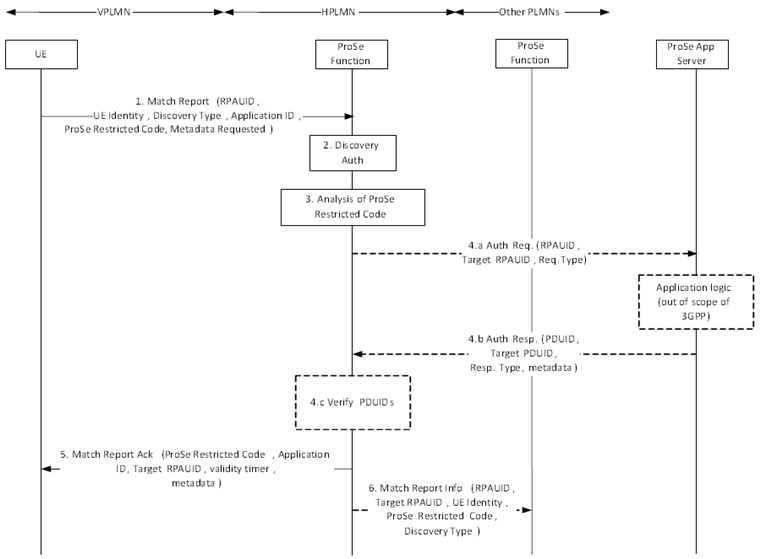
Figure 5.3.4.2A-1: Match Report procedure for restricted discovery (roaming)
(⇒ copy of original 3GPP image)
(⇒ copy of original 3GPP image)
Step 1.
When the monitoring UE has received a ProSe Restricted Code over the air that matches the Discovery Filter it obtained from monitoring Request procedure, and if the UE does not have a corresponding RPAUID associated with it with a valid TTL, the UE sends a Match Report (RPAUID, UE Identity, Discovery Type, Application ID, ProSe Restricted Code, Metadata Requested, Monitored PLMN ID) message to the ProSe Function in the HPLMN to get the Target RPAUID. The RPAUID is the identifier the monitoring UE used to obtain the Discovery Filter from the Monitoring Request. The UE Identity is set to e.g. IMSI. The Application ID represents a unique identifier of the application that triggered the monitoring Request. Discovery Type is set to "restricted discovery". The ProSe Restricted Code is the code received over the air. The Monitored PLMN ID is that of the PLMN in which the UE monitored the ProSe Restricted Code.
If restricted Direct Discovery with application-controlled extension is used, the UE may initiate a Match Report procedure if there is match on the ProSe Restricted Code Prefix, and there is a match on the ProSe Restricted Code Suffix, but the ProSe Protocol layer in the UE doesn't have the ProSe Restricted App User ID corresponding to the ProSe Restricted Code Prefix stored locally. Once the ProSe Protocol layer in the UE has got the ProSe Restricted App User ID corresponding to the ProSe Restricted Code Prefix stored locally, the ProSe Restricted Code Suffix is passed to the application in the UE.
If the monitoring UE decides that it needs to obtain the latest metadata, e.g. when the Metadata Indicator allows metadata update, and the UE has noticed a change of the metadata (e.g. from the suffix or via other means), it includes the Metadata Requested in the Match Report message.
Step 2.
The HPLMN ProSe Function checks the authorization for the monitoring UE to perform restricted discovery.
Step 3.
The HPLMN ProSe Function analyses the ProSe Restricted Code and identifies in the UE context of the monitoring UE the corresponding Target RPAUID.
Step 4.a.
Optionally, the ProSe Function sends a Auth Request (RPAUID, Target RPAUID, Request Type) to the ProSe Application Server. The ProSe Function locates the ProSe Application Server based on the Application ID. The Request Type is set to "restricted discovery/match". If the Metadata Requested is included in the Match Report in step 1, the ProSe Function shall send the Auth Request message.
Step 4.b.
If, based on the permission setting, the RPAUID is allowed to discover the Target RPAUID, the ProSe Application Server returns a Auth Response (PDUID, Target PDUID, Response Type, metadata) message. The PDUID corresponds to RPAUID, the Target PDUID corresponds to the Target RPAUID stored in the ProSe Application Server. The Response Type is set to "restricted discovery/match ack". This message may also contain certain metadata corresponding to the Target PDUID, e.g. welcome message, etc.
Step 4.c.
The ProSe Function verifies that the returned PDUID belongs to the requesting UE, and the Target PDUID is the same as the stored Target PDUID.
Step 5.
The ProSe Function in HPLMN returns a Match Report Ack (Application ID, Target RPAUID, validity timer, metadata (opt.)) to the UE. The UE stores the mapping between the RPAUID, the ProSe Restricted Code and the Application ID for the duration of the validity timer.
Step 6.
The ProSe Function in HPLMN may optionally send a Match Report Info (RPAUID, Target RPAUID, UE Identity, ProSe Restricted Code, Discovery Type) to the ProSe Function in the HPLMN of the announcing UE. Discovery Type is set to "restricted discovery". If the Monitored PLMN ID is different from that of the Target PDUID, i.e. the "announcing UE" is roaming or performs inter-PLMN discovery transmission, the ProSe Function in HPLMN of the Monitoring UE may send another Match Report Info (RPAUID, Target RPAUID, UE Identity, ProSe Restricted Code, Discovery Type) to the ProSe Function of the PLMN indicated by the Monitored PLMN ID.
5.3.4A Discovery reporting - Model B procedures |R13| p. 88
5.3.4A.1 Match report (non-roaming) - restricted discovery p. 88
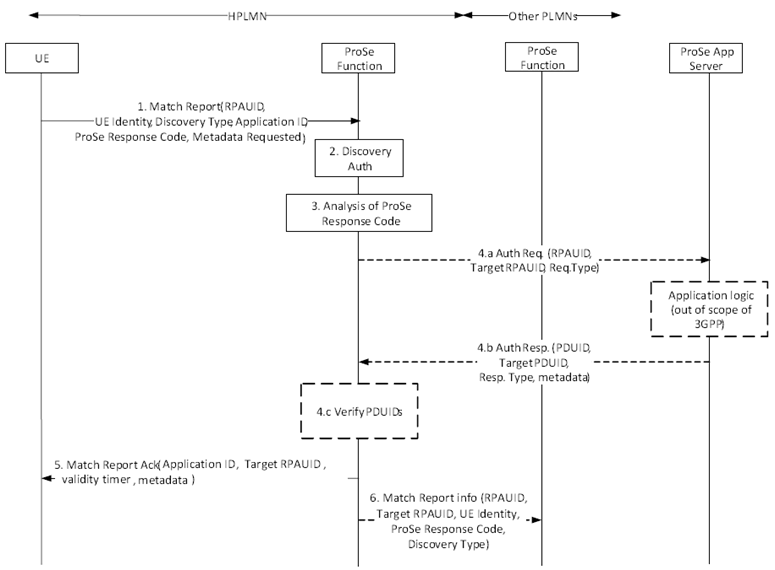
Figure 5.3.4A.1-1: Match Report procedure for Model B restricted discovery (non-roaming)
(⇒ copy of original 3GPP image)
(⇒ copy of original 3GPP image)
Step 1.
When the Discoverer UE has received a ProSe Response Code over the air that matches the Discovery Response Filter it obtained from Discoverer Request procedure, and if the UE does not have a corresponding RPAUID associated with it with a valid TTL, the UE sends a Match Report (RPAUID, UE Identity, Discovery Type, Application ID, ProSe Response Code, Metadata Requested) message to the ProSe Function in the HPLMN to get the Target RPAUID. The RPAUID is the identifier that the Discoverer UE used to obtain the Discovery Response Filter(s) from the Discoverer Request procedure. The UE Identity is set to e.g. IMSI. The Application ID represents a unique identifier of the application that triggered the Discoverer Request procedure. Discovery Type is set to "restricted discovery". The ProSe Response Code is the code received over the air.
If the monitoring UE decides that it needs to obtain the latest metadata, e.g. when the Metadata Indicator allows metadata update, and the UE has noticed a change of the metadata, it includes Metadata Requested in the Match Report message.
Step 2.
The HPLMN ProSe Function checks the authorization for the Discoverer UE to perform restricted discovery.
Step 3.
The HPLMN ProSe Function analyses the ProSe Response Code and identifies in the UE context of the Discoverer UE the corresponding Target RPAUID.
Step 4.a.
Optionally, the ProSe Function sends a Auth Request (RPAUID, Target RPAUID, Request Type) to the ProSe Application Server. The ProSe Function locates the ProSe Application Server based on the Application ID. The Request Type is set to "restricted discovery/match". If the Metadata Requested is included in the Match Report in step 1, the ProSe Function shall send the Auth Request message.
Step 4.b.
If, based on the permission setting, the RPAUID is allowed to discover the Target RPAUID, the ProSe Application Server returns a Auth Response (PDUID, Target PDUID, Response Type, metadata) message. The PDUID corresponds to RPAUID, the Target PDUID corresponds to the Target RPAUID stored in the ProSe Application Server. The Response Type is set to "restricted discovery/match ack". This message may also contain certain metadata corresponding to the Target PDUID, e.g. welcome message, etc.
Step 4.c.
The ProSe Function verifies that the returned PDUID belongs to the requesting UE, and the Target PDUID is the same as the stored Target PDUID.
Step 5.
The ProSe Function in HPLMN returns a Match Report Acknowledgement (Application ID, Target RPAUID, validity timer, metadata (optional)) message to the UE. The UE stores the mapping between the RPAUID, the ProSe Response Code and the Application ID for the duration of the validity timer.
Step 6.
The ProSe Function in HPLMN may optionally send a Match Report Info (RPAUID, Target RPAUID, UE Identity, ProSe Response Code, Discovery Type) to the ProSe Function of the Discoveree UE. The Discovery Type is set to "restricted discovery".
5.3.4A.2 Match report (roaming/inter PLMN discovery transmission) - restricted discovery p. 90
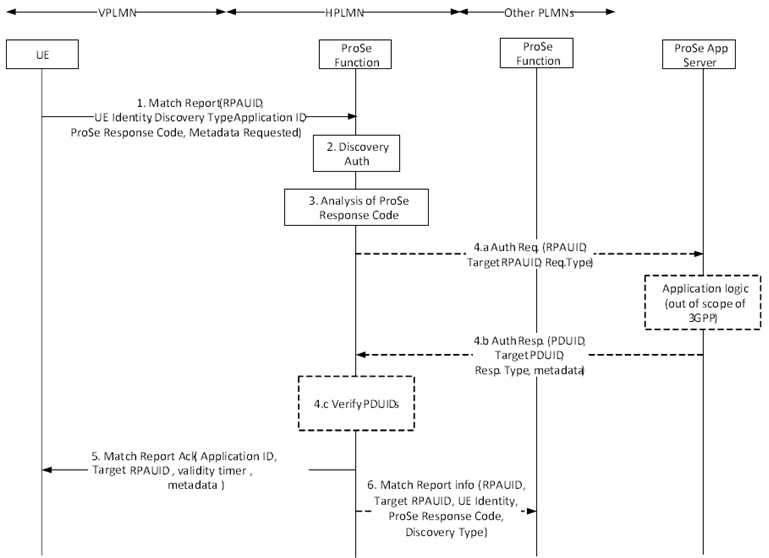
Figure 5.3.4A.2-1: Match Report procedure for Model B restricted discovery (roaming)
(⇒ copy of original 3GPP image)
(⇒ copy of original 3GPP image)
Step 1.
When the Discoverer UE has received a ProSe Response Code over the air that matches a Discovery Response Filter it obtained from the Discoverer Request procedure, and if the UE does not have a corresponding RPAUID associated with it with a valid TTL, the UE sends a Match Report (RPAUID, UE Identity, Discovery Type, Application ID, ProSe Response Code, Metadata Requested, Monitored PLMN ID) message to the ProSe Function in the HPLMN to get the Target RPAUID. The RPAUID is the identifier that the Discoverer UE used to obtain the Discovery Response Filter from the Discoverer Request procedure. The UE Identity is set to e.g. IMSI. The Application ID represents a unique identifier of the application that triggered the Discoverer Request procedure. Discovery Type is set to "restricted discovery". The ProSe Response Code is the code received over the air. The Monitored PLMN ID is that of the PLMN in which the UE monitored the ProSe Response Code.
If the monitoring UE decides that it needs to obtain the latest metadata, e.g. when the Metadata Indicator allows metadata update, and the UE has noticed a change of the metadata, it includes the Metadata Requested in the Match Report message.
Step 2.
The HPLMN ProSe Function checks the authorization for the Discoverer UE to perform restricted discovery.
Step 3.
The HPLMN ProSe Function analyses the ProSe Response Code and identifies in the UE context of the Discoverer UE the corresponding Target RPAUID.
Step 4.a.
Optionally, the ProSe Function sends a Auth Request (RPAUID, Target RPAUID, Request Type) to the ProSe Application Server. The ProSe Function locates the ProSe Application Server based on the Application ID. The Request Type is set to "restricted discovery/match". If the Metadata Requested is included in the Match Report in step 1, the ProSe Function shall send the Auth Request message.
Step 4.b.
If, based on the permission setting, the RPAUID is allowed to discover the Target RPAUID, the ProSe Application Server returns a Auth Response (PDUID, Target PDUID, Response Type, metadata) message. The PDUID corresponds to RPAUID, the Target PDUID corresponds to the Target RPAUID stored in the ProSe Application Server. The Response Type is set to "restricted discovery/match ack". This message may also contain certain metadata corresponding to the Target PDUID, e.g. welcome message, etc.
Step 4.c.
The ProSe Function verifies that the returned PDUID belongs to the requesting UE, and the Target PDUID is the same as the stored Target PDUID.
Step 5.
The ProSe Function in HPLMN returns a Match Report Acknowledgement (Application ID, Target RPAUID, validity timer, metadata (optional)) message to the UE. The UE stores the mapping between the RPAUID, the ProSe Response Code and the Application ID for the duration of the validity timer.
Step 6.
The ProSe Function in HPLMN may optionally send a Match Report Info (RPAUID, Target RPAUID, UE Identity, ProSe Response Code, Discovery Type) to the ProSe Function in the HPLMN of the Discoveree UE. Discovery Type is set to "restricted discovery". If the Monitored PLMN ID is different from that of the Target PDUID, i.e. the "announcing UE" is roaming or performs inter-PLMN discovery transmission, the ProSe Function in HPLMN of the Monitoring UE may send another Match Report Info (RPAUID, Target RPAUID, UE Identity, ProSe Restricted Code, Discovery Type) to the ProSe Function of the PLMN indicated by the Monitored PLMN ID.